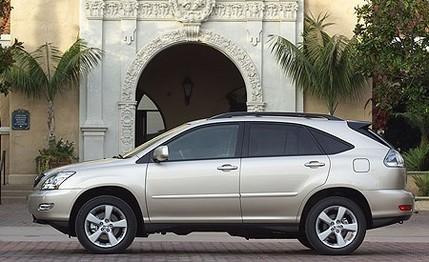 First Drive Review
First Drive Review
In 1998, Lexus introduced a wonder drug to an already SUV-addicted populace-Cipro, Lipitor, Ginkgo biloba, and maybe a grain or two of Prozac all rolled into one, and badged RX300. "Euphoric-high seating position, go-anywhere energy, no truckish side effects!" So addictive was this four-wheel intoxicant that five years later, in a market flooded with effective generic equivalents, the RX still holds 22 percent of the luxury-ute market. Nevertheless, to keep its regulars hooked, the pharmacists at Lexus are upping the dosage for 2004 with this RX330.
There's more of everything-space, power, even refinement. The capsule itself is about six inches longer, an inch wider, and a half-inch taller. Inside, the passengers only get an extra four cubic feet of stretch-out space, mostly in the front seat. On paper, the cargo hold expands by 10 cubes to 85 with the seats down, but that stylish rear window rakes right through the usable space, reducing seats-up volume by 1.5, to 38 cubic feet.
Styling was a big part of the RX300's allure, and the designers of the RX330 tried hard to trump themselves in the uniqueness department. Maybe too hard. The front is fresh, evolutionary, and sporty, as is the IS300 SportCross-like greenhouse. But the glass sits atop a slightly too tall and too slab-sided midsection and tail, and the fast-'n'-furious clear taillamps (aren't these a cliché yet?) cling to the high rear window, leaving a broad, Ford Focus-like expanse of tailgate below. Functionally, that high beltline restricts rear-seat visibility somewhat-then again, maybe this appeals to today's hunkered-down bunker society.
Functional enhancements abound. The adjustable rear seatbacks can now be folded in 40/20/40 segments, permitting, say, a surfboard to ride in the trunk pass-through between two surfers. The rear seats still slide fore and aft about five inches to apportion cargo and passenger space as necessary. The spare tire hangs outside beneath the cargo floor, freeing up room for underdeck stowage, including a place to stash the cargo cover. A clever latching system automatically reels in the cargo cover when the rear hatch is opened, and a power-operated hatch is now optional, as is a huge three-panel glass sunroof that gives front- and rear-seat passengers a great view up.
The dirty parts are all greatly revised as well. As the name suggests, the familiar V-6 has been bored out to 3.3 liters, with a commensurate bump in potency of 10 horsepower and 20 pound-feet of torque, to 230 and 242. The power and torque peaks are lower, too. This extra-strength six is now mated to a five-speed automatic with a much wider ratio spread than the previous four-speed's, which contributes greatly to the claimed increases in performance: 0-to-60 times improve by 0.8 second for the front-driver and by a full second with all-wheel drive to 7.7 and 7.8 seconds, respectively. Fuel economy is also up slightly on the EPA cycles to 20 city and 26 highway with front-wheel drive and 18 and 24 with four-wheel drive, despite a weight gain of about 150 pounds.
Lexus simplified the RX's all-wheel-drive system this year by ditching the viscous limited slip on the 50/50 torque-splitting center differential, leaving the traction- and stability-control hardware to apportion the torque in slippery conditions (the Torsen-rear-diff option was dropped after 2000). We scrambled up a badly eroded dirt road without difficulty, but so might a rear-wheel-drive pickup.